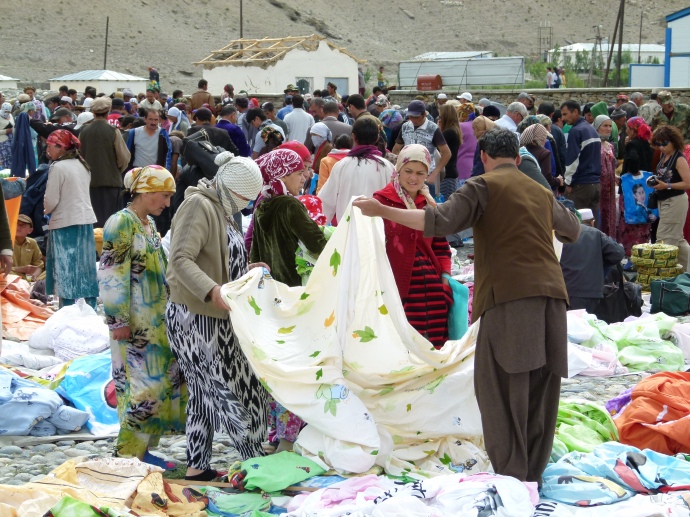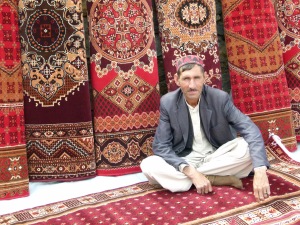Afghan market on Tajik border
After about a six-week hiatus, I am hanging out where posting on nancystan is possible. I have a lot to share, but it will not be chronological. This is the first posting on our trip to the Pamir Mountains, June 17-27. Postings on Uzbekistan will follow, plus our overland trip from Khujand to Dushanbe.
We had a full day on June 23, and our first stop was at the Saturday Afghan market. There’s an island in the Panj * River, the border between Afghanistan and Tajikistan. Because the Afghani people are mostly Tajiks in this area, it was difficult to tell the women apart. Afghan men have distinctive dress. (You all have seen it in the news.) Tajik men tend to dress in pants and shirts like Westerners, although they often sport their ethnicity-identifying caps. This is not the area of the Taliban, and I wasn’t sure if the Tajik and Afghan women dressed more or less the same, or perhaps there were no Afghan women. There were certainly no burkas or women covered any more than some of the conservative Tajik women. I did notice on the side of the Tajik road when we went through villages and also in the market itself that some women covered the lower part of their face – in the style of cowboy bandits. I wasn’t sure if it was for modesty or to protect from the sun and dust. Our Khorog contact Favzyia told us later that it was for protection from the elements, not because of religion.

Notice the range of dressing among these women. One young woman in a hoody is using a cellphone while two others have their faces covered with a scarf, bandito style.
The merchandise in the market was not all that interesting. I was hoping to score some good jewelry, or at least some handicrafts, but the jewelry was of the cheap, probably-made-in-India variety. Other wares were clothes, cloth, shoes, rugs, plastic items, some food stuffs, etc. We hadn’t seen any fresh fruit for several days, so I did buy some delicious, little, too-ripe-already bananas.
We needed our passports to get onto the island. Military posts were on both sides of the bridge, and we would not have been allowed to cross to Afghanistan. As we walked off the island, David pointed the camera in that direction and we were told by hand gestures and the phrase “no photos” that photographs were forbidden. Pretty silly, since once we were off no-man’s-land and back in Tajikistan, we could easily use the zoom lens to take the same photos. But, overall, the soldiers were friendly to us and the other foreigner tourists who had arrived for the weekly market.
Rug merchant on left.
Stereotypical face shot on right,but I couldn’t resist.
Later, as we were driving out of the Pamirs, I learned that there is an Afghan consulate in Khorog (the largest town in the Tajik side of the Pamir Mountains.) Tajiks on the Tajikistan side can get permission to cross over easily into Afghanistan to visit relatives or just visit and sight-see in that area. If I had known that, I might have tried to see how easy it would be for an American to get a day-visa, or something like that. It would feel so “naughty” to drop in that way, and likely would have not been liked at the US embassy in Dushanbe. I suspect, however, that it would not have been possible.
One of the people we met in the Pamirs was a Pamiri who works in Moscow as an electrician, but comes home every year to hike in his beloved mountains. He has a vision of a “greater Tajikistan” which would include parts of Uzbekistan (Bukhara and Samarkand, subjects of future posts on nancystan) and the northern territory of Afghanistan. As in many (most?) colonial situations, the national boundaries were drawn without taking into account where the ethnic groups actually lived.
I took most of the photos used on this post. I will credit David when they are his.
*Panj is a transliteration from Cyrillic, so it may be spelled different ways in Latin letters. The Lonely Planet guidebook spells it Pyanj. It means “five,” because five rivers come together to form it. It eventually flows into the Amu Darya (formerly known as the Oxus River), which continues to be the border between Afghanistan and Tajikistan and then Turkmenistan and Uzbekistan, before eventually flowing into the Aral Sea. (What’s left of it, at least, as much is siphoned off for irrigating cotton crops.)






I liked your first photo of the market. In miy mind, maybe because of the closeness to Afghanistan and all the media photographs/videos of Afghanistan’s remote regions, I had assumed that all women would be wearing traditional clothes and covering at least their hair. I knew it wasn’t going to be all burkas but this photo really shows the diversity, even in this far flung corner fo the world. If I were there with you, you know we would have gone to Uzbekistan.
Posts from our Uzbekistan trip will be coming up soon. I am not working chronologically at all!
‘Panj’ is a correct Tajik designation of the river. ‘Pyanj’ is a Russianized version.
Interesting blog!
Thanks for the information!
these are interesting photos to know about tajik culture. if you have more photos also upload on the page.